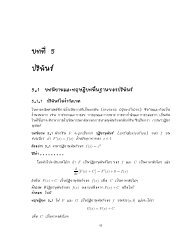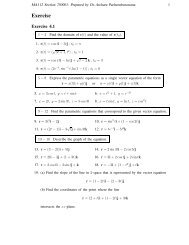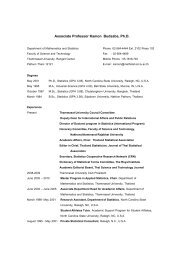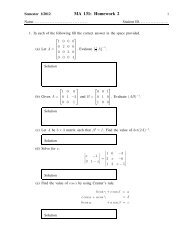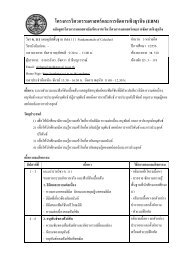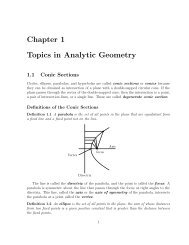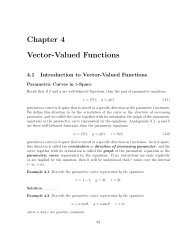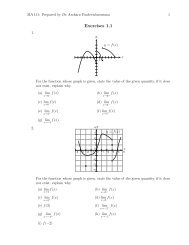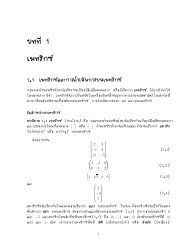Chapter 1 Topics in Analytic Geometry
Chapter 1 Topics in Analytic Geometry
Chapter 1 Topics in Analytic Geometry
Create successful ePaper yourself
Turn your PDF publications into a flip-book with our unique Google optimized e-Paper software.
•••••••MA112 Section 750001: Prepared by Dr.Archara Pacheenburawana 74s = 3s = 2s = 1Reference po<strong>in</strong>ts = −1s = −2s = −3CLet us now treat s as a variable. As the value of s changes, the correspond<strong>in</strong>g po<strong>in</strong>tP moves along C and the coord<strong>in</strong>ate of P become functions of s. Thus, <strong>in</strong> 2-space thecoord<strong>in</strong>ate of P are (x(s),y(s)), and <strong>in</strong> 3-space they are (x(s),y(s),z(s)). Therefore <strong>in</strong>2-space or 3-space the curve C is given by the parametric equationsx = x(s), y = y(s), or x = x(s), y = y(s), z = z(s)A parametric representation of a curve with arc length as the parameter is called an arclength parametrization of the curve.Example 4.19 F<strong>in</strong>d the arc length parametrization of the circle x 2 + y 2 = a 2 with counterclockwiseorientation and (a,0) as the reference po<strong>in</strong>t.Solution .........Change of ParameterA change of parameter <strong>in</strong> a vector-valued function r(t) is a substitution t = g(τ) thatproduce a new vector-valued function r(g(τ)) have the same graph as r(t), but possiblytraced differently as the parameter τ <strong>in</strong>creases.Example 4.20 F<strong>in</strong>d a change of parameter t = g(τ) for the circlesuch thatr(t) = costi+s<strong>in</strong>tj (0 ≤ t ≤ 2π)(a) the circle is traced counterclockwise as τ <strong>in</strong>creases over the <strong>in</strong>terval [0,1];(b) the circle is traced clockwise as τ <strong>in</strong>creases over the <strong>in</strong>terval [0,1].Solution .........Theorem 4.7 (Cha<strong>in</strong> Rule) Let r(t) be a vector-valued function <strong>in</strong> 2-space or 3-spacethat is differentiable with respect to t. If t = g(τ) is a change of parameter <strong>in</strong> which g isdifferentiable with respect to τ, then r((g(τ)) is differentiable with respect to τ anddrdτ = dr dtdt dτ(4.26)



